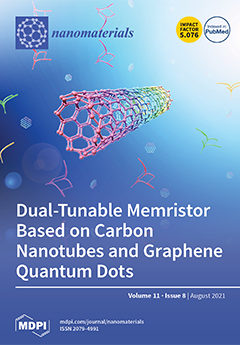In the present work, a thermal treatment technique is applied for the synthesis of Ce
xSn
1−xO
2 nanoparticles. Using this method has developed understanding of how lower and higher precursor values affect the morphology, structure, and optical properties of Ce
[...] Read more.
In the present work, a thermal treatment technique is applied for the synthesis of Ce
xSn
1−xO
2 nanoparticles. Using this method has developed understanding of how lower and higher precursor values affect the morphology, structure, and optical properties of Ce
xSn
1−xO
2 nanoparticles. Ce
xSn
1−xO
2 nanoparticle synthesis involves a reaction between cerium and tin sources, namely, cerium nitrate hexahydrate and tin (II) chloride dihydrate, respectively, and the capping agent, polyvinylpyrrolidone (PVP). The findings indicate that lower x values yield smaller particle size with a higher energy band gap, while higher x values yield a larger particle size with a smaller energy band gap. Thus, products with lower x values may be suitable for antibacterial activity applications as smaller particles can diffuse through the cell wall faster, while products with higher x values may be suitable for solar cell energy applications as more electrons can be generated at larger particle sizes. The synthesized samples were profiled via a number of methods, such as scanning electron microscopy (SEM), transmission electron microscopy (TEM), X-ray diffraction (XRD), and Fourier transform infrared spectroscopy (FT-IR). As revealed by the XRD pattern analysis, the Ce
xSn
1−xO
2 nanoparticles formed after calcination reflect the cubic fluorite structure and cassiterite-type tetragonal structure of Ce
xSn
1−xO
2 nanoparticles. Meanwhile, using FT-IR analysis, Ce-O and Sn-O were confirmed as the primary bonds of ready Ce
xSn
1−xO
2 nanoparticle samples, whilst TEM analysis highlighted that the average particle size was in the range 6−21 nm as the precursor concentration (Ce(NO
3)
3·6H
2O) increased from 0.00 to 1.00. Moreover, the diffuse UV-visible reflectance spectra used to determine the optical band gap based on the Kubelka–Munk equation showed that an increase in x value has caused a decrease in the energy band gap and vice versa.
Full article






